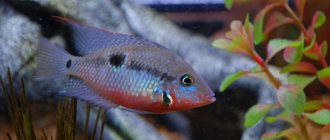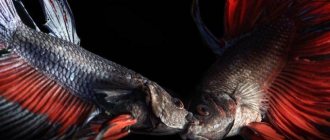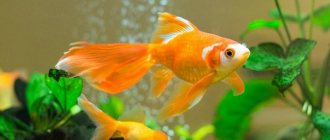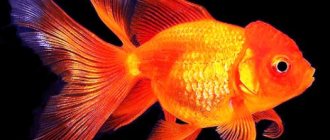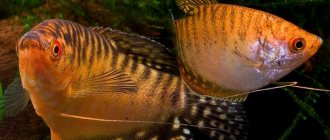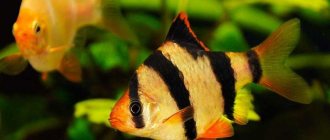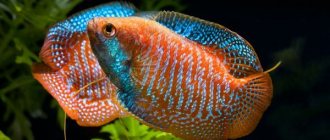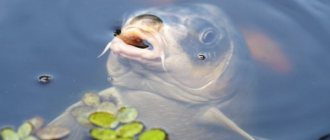Cichlids
Simplicity of content:
The unusual color and variety of shapes and sizes of fish from the cichlid family attracts many aquarists. But due to their difficult nature, most representatives of this species do not get along with other pets. Therefore, before introducing cichlids into a community aquarium, compatibility with other fish must be taken into account first.
To do this, you need to know which species can become good neighbors for cichlids, and which fish they cannot get along with under any circumstances.
Good neighbors
Before populating an artificial reservoir with cichlids, you need to familiarize yourself with the characteristics of this species. The character of fish is complex; not all species can coexist with them without danger.
Most aquarists are confident that cichlids get along only with representatives of three species:
- astronotuses;
- botia;
- acne.
Eels are able to resist ray-finned animals, so the pets will simply divide the territory so as not to intersect.
But catfish can also become good neighbors for cichlids. Cichlids prefer the upper and middle layers of the reservoir and catfish swimming in the bottom layer do not disturb them.
The compatibility chart applies to all cichlids.
Equipment
Often, when starting a cichlid fish, aquarists prefer to do without natural flora. However, it serves an important function. In addition to decorating the aquarium, it primarily absorbs nitrates and phosphates, which in high concentrations can cause irreparable damage to fish. That is, this is a biological filter, and if it is missing, then the entire load falls exclusively on one filter.
Conventional indoor type equipment is not suitable. It is better to purchase an external model, since these filters are more productive, and the owner of the aquarium has the opportunity to independently select fillers, focusing on mechanical, chemical or biological cleaning. If you want to save money, you can make a bio or phytofilter yourself.
As for the lighting of the cichlid, it is not particularly important. But, as a rule, fluorescent lamps or LEDs are chosen.
Unsuitable roommates
Cichlids are considered predatory fish, so many species do not get along with them. Most representatives of cichlids cannot tolerate small, slow neighbors.
You cannot add to ray-finned:
- cockerels;
- swordtails;
- goldfish;
- guppy;
- mollies;
- iris;
- zebrafish;
- gourami;
- telescope;
- platy.
The appearance of strangers in the aquarium causes aggression in cichlids and they can kill them.
Conflict sometimes arises even within the same species. For example, male parrots cannot stand competition and engage in fights with each other, which ends only after the leader destroys the rest of the brothers. Therefore, it is impossible to house several male parrots together.
The Queen of Tanganika is a crown territorial fish!
Some subspecies of cichlids can coexist only with representatives of their own species. Pseudotropheus is ready to attack anyone who gets in the way, and the Queen of Tanganyika, although not so aggressive, does not tolerate the invasion of strangers into her territory. Therefore, it is recommended to keep them separately, forming flocks of several females and one male.
Errors
- Incorrect arrangement. In addition to the temperament and size of the fish, consider the arrangement of the aquarium. For example, loaches burrow into the ground, so a sandy substrate is needed. Territorial species share the aquarium with thickets of plants. Unsociable and timid inhabitants of the waters are provided with subdued light and shaded areas.
- Overpopulation in the aquarium. There should be enough space for the fish to move freely. Clashes, rapid deterioration of water quality, and lack of oxygen are inevitable in an overcrowded aquarium.
- The composition and parameters of water are not taken into account. You can achieve complete similarity according to the fish compatibility table, but do not take into account the required parameters of the aquarium neighbors. Some fish may be similar in character to others, but the difference in water parameters will not allow them to live in the same aquarium. Incorrectly selected water parameters cause stress, reducing immunity.
- Population of fish of the same sex. Some species need to spawn for a comfortable existence. In cichlids, bettas and other species, males are aggressive towards each other.
- The type of food is not taken into account. Fish feed on the surface of the water, in the thickness or at the bottom, it depends on the structure. Bottom dwellers do not eat small flakes, and fish with an upper mouth will remain hungry if you throw sinking food into the aquarium.
- Inoculation of unsuitable plants. Some aquatic pets are prone to eating certain types of flora. Keep this in mind when landscaping your aquarium.
Relatively compatible species
The character of cichlids depends on the area to which they belong. People from different regions have different behavioral habits towards their neighbors. There are quite peaceful individuals that can coexist with other inhabitants of an artificial reservoir.
The table shows the compatibility of some representatives of cichlids with other species of fish:
| Subspecies name | Suitable neighbors |
| Cichlazoma severum | Astronotus, catfish |
| Cichlazoma Meeka | Angelfish, acara |
| Cichlazoma bees (eight-striped) | Plextomus, black pacu, brocade pterygoplichtha |
| Astronotus | Proportional representatives of ray-finned fish |
| Princess of Burundi | Non-aggressive relatives |
| Melanochromis Johana | Lemon cichlid, hummingbird, lombardi, ocellaris |
| Handsome Chromis | Acaras, bees |
| Angelfish | Metenas, mollies, platies, catfish |
| Auratus "Golden Parrot" | Pseudotropheus, fast-swimming fish that prefer the upper layers of the aquarium |
| Teraps (Japanese parrot) | Cichlosoma Meeka, Congo, Barbus, Mettinis, Acara |
| Ramiresi's apistrogram | Neons, swordtails, guppies, platies, rhodostomuses |
| Blue dolphin | African catfish, frontosa |
All types of cichlids are relatively compatible with other fish, provided they are raised together from juvenile age. In such cases, even the most cocky fish can be kept together with neighbors that seem unsuitable for them. But this is only possible for young individuals. Adult fish are more belligerent and can be quite unfriendly towards strangers.
Factors that improve livability:
To reduce aggressiveness, you need to create comfortable living conditions for cichlids and organize proper care for them.
Compliance with the following rules will help improve the coexistence of inhabitants of different species:
- Selecting a container whose volume will correspond to the size of the flock. Overpopulation can lead to the death of herbivorous species.
- Timely feeding of a variety of foods. Due to lack of food, hungry predators will attack weaker fish.
- Proper decoration of the aquarium, division into zones using a sufficient number of grottoes and shelters. This will help avoid territorial wars.
If you decide to stock several species of fish in one aquarium, then it is better to purchase fry of approximately the same age and stock them at the same time. Cichlids that have grown up with other pets get used to them and do not offend them.
It is much easier for the fry to get along with other fish.
It is not advisable to add juveniles to adults. The older comrades will constantly terrorize the young animals, interfering with their normal existence. It is recommended to add fish of equal size to cichlids, with no less fighting character than theirs.
When buying cichlids, you should definitely familiarize yourself with the placement features of the species you are purchasing. And before adding neighbors to them, make sure the fish get along well.
Description and habitat
Cichlids live on almost all continents of the world, with almost half of the species found in two unique lakes in Africa - Tanganyika and Malawi (Nyasa), which can be called a natural laboratory. Over millions of years of development, from the few fish that found their way into these ancient bodies of water, multiple species evolved.
Cichlids are most often territorial varieties of perciformes, varying significantly in size and shape depending on their habitat, and are usually quite hostile. They prefer fresh water, but they also thrive in salt water.
The main species of cichlids have a rounded, tall body, slightly flattened on the sides, with a large head and a mouth with well-defined lips. As males grow older, a fatty growth appears on their forehead.
Most varieties are monogamous, choosing one partner for their entire long life (from 10 to 25 years).
Photo gallery of cichlids:
For aquaculture enthusiasts, this is mostly a complex fish; only some species are quite unpretentious, for example, black stripe, meeka, and angelfish.
The lifespan of cichlids is determined by their habitat; at high water temperatures, metabolism and biorhythm accelerate. In cool (to a certain limit) fish live longer.
Aquasalons usually sell teenage cichlids, their age is about 2-6 months. Young animals have a paler color, smaller body and fins, and their sexual characteristics are not clearly expressed.
Cichlid maintenance requirements
Cichlids belong to the order Perciformes of the ray-finned family. The number of species is quite large and their habitat is the most diverse - the waters of Africa, Asia and America. Therefore, when choosing living conditions for pets, you should take into account the geographical location of the species.
Bright cichlids are the best neighbors for a friend
For American river fish, soft water with a low acidity level is suitable. Lake dwellers will require harder and more alkaline water.
But there are general requirements that apply to all types:
- Capacious tank with a capacity of at least 150 liters. It is advisable to choose an aquarium with a volume of 250-300 liters.
- Optimal temperature conditions. For most cichlids it is 25-28°C. The exception is the red-breasted carp, which can live at temperatures of 14-15°C.
- Availability of powerful filters and aeration system.
- Weekly replacement of a third of the water.
- Adjust the lighting to moderate levels so that bright rays do not disturb your pets.
To create comfortable conditions for the fish, you need to properly decorate the tank. The bottom of the aquarium is laid out with sandy or rocky soil, preferably flat stones.
A cichlid (cichlidarium) is an ascetically designed aquarium, the main decoration of which is its inhabitants.
Since most living plants will be destroyed by predators, it is recommended to place artificial greenery or vegetation with tough foliage and strong roots in the aquarium. In addition, cichlids love to dig up the soil, so it is better to give preference to Anubias, which do not require planting in the ground.
The decoration of the aquarium, which should be similar to its habitat, is of no small importance. The space of the reservoir must be demarcated with the help of shelters, stones, artificial grottoes, and caves. Cichlids are quite jealous of their territory and do not allow strangers to encroach on it. A collision with a weaker individual can be fatal for the latter. Therefore, it is impossible to do without zoning the territory.
If desired, you can purchase special aquariums - cichlidariums, designed for keeping cichlids. Often, when equipping such a tank, manufacturers take into account the needs of a particular species in accordance with its geographical location, feeding and reproduction characteristics.
When organizing cichlid feeding, it is necessary to take into account the type of fish. Suitable for herbivores:
- lettuce leaves;
- spinach;
- dandelions;
- cucumbers;
- carrot;
- zucchini;
- spirulina tablets.
Do not forget about maintaining a nutritional balance, so meat foods should also be added to the diet of herbivores.
But there should be more plant feeding, otherwise the fish will begin to feed on the plants, ruining their appearance.
Predators prefer protein foods, so they need to be fed:
- squid;
- fish;
- shrimp;
- live food (bloodworms, artemia, nauplii).
To replenish vitamin reserves, predators are periodically fed plant foods.
Pets are fed several times a day. Portions should be such that the fish have time to eat the food in a few minutes.
24:44
Feeding Malawian cichlids (Mbuna)
06:57
Feeding lake cichlids Malavia and Tanganyika.
03:08
How to feed cichlids
Breeding cichlids comes with some challenges. The fish choose a pair on their own, but they are not always able to quickly have offspring.
A pair ready to spawn is placed in a separate tank, since future parents jealously guard their offspring, becoming especially aggressive during this period.
The diet of young animals should be varied. Feeding is carried out 5-6 times a day, including crustaceans, plankton, brine shrimp, and rotifers in the menu. Grown-up babies are fed bloodworms, tubifex and live daphnia.
The lifespan of the pets depends on how correctly the cichlids are cared for. Some of them can live up to 10 years or more.
Nutrition
Feeding catfish is even simpler than keeping them. If your pets live in a tank with other fish, then you don’t have to feed the catfish at all - they will happily pick up leftover food from their neighbors, at the same time cleaning the area. When keeping only catfish fish, you can offer your wards the following products:
- Live and frozen food: bloodworms, tubifex, cyclops, shrimp, etc.
- Catfish tablets and flakes.
- Plant foods: cucumber, spinach, green peas, broccoli, etc.
Before serving, live food must be thoroughly washed, and plant food must be scalded with boiling water. If a predatory catfish lives in the tank, you should remember that small neighbors can become its lunch.
Interesting fact: hungry and predatory catfish living in their natural environment can drag even a dog to the bottom.
